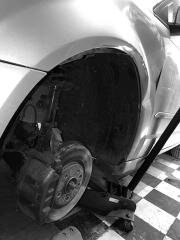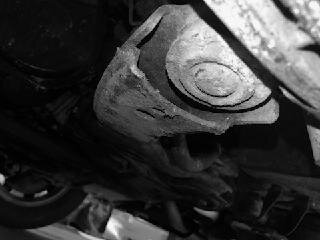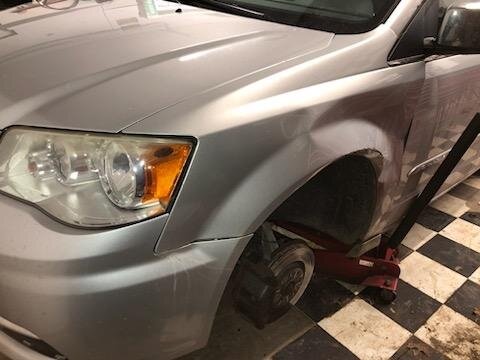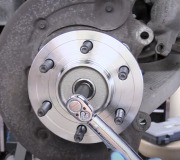Logic would dictate this is the result of improper installation, but it's impossible to know which time the damage occurred. We've been preaching since the 1970s the importance of using a click-type torque wrench when tightening lug nuts. Air-powered impact wrenches can easily over-tighten the nuts. That can cause the threads to peel, or the tapered friction surfaces can grind down. Peeling threads show up the next time the nuts are removed, but it's that current mechanic who gets the undeserved blame. Sometimes the nuts won't even come off; they'll just spin. If the threads are not peeled, over-tightening can cause the contact areas of the nuts to grind away, as well as the mating surfaces on the wheel. Once that happens, there's much too little surface area to hold the nuts from working loose. They will loosen as you drive.
The sounds you described are the classic sounds of a loose wheel. Stop driving until the nuts are tightened again, however the damage has already been done. The nuts will likely hold the wheel tight long enough to return to the shop, but the wheel and the nuts must be replaced. To continue driving pretty much guarantees the wheel is going to come off.
The same problems occur when the nuts are not tightened sufficiently. Microscopic movement between them and the wheel grinds the metal away and increases the looseness, ... Which leads to more grinding away.
Another problem can occur when a well-meaning mechanic puts grease on the wheel studs. Many cars, including almost all imports, use: "anodized" studs. That's an electroplated coating that makes them look light blue, light yellow, or silver. That coating is a lubricant. Grease will deteriorate that coating and can lead to "galling". That's similar to the threads tearing away. For regular studs, a very light film of grease is fine, but problems are caused when too much is smeared on. When I do that, I run the nuts on all the way by hand, then use air tools and a torque wrench. When air tools are used to spin the nuts on, the grease can build up ahead of them and gets sprayed outward onto the friction surfaces. Those contact surfaces must remain dry to hold the nuts from coming loose.
Also be aware some do-it-yourselfers will use anti-seize compound on the studs. This is one application where it must never be used. A mechanic caught using it here will likely get fired. The material is so slippery, it almost guarantees the nuts will work loose.
The wheel studs can be replaced without replacing the entire wheel bearing assembly, but it is absolutely required the nuts and wheel must be replaced too. The nuts have a curved friction surface that exactly matches that on the wheel. Those contact points are what holds the nuts from coming loose. If you try to save a few bucks by reusing the wheel, it is 100 percent guaranteed it is going to come loose again. This is one place where even I would not try to cheap out. Be aware when the new studs are pulled in, they may not become fully seated right away. Standard practice is to retorque them within about 50 miles, then perhaps once more after another 50 miles. If they no longer rotate slightly before the torque wrench clicks, they can be considered fully seated and properly tightened. A lot of shops even want to recheck the nuts after they reinstall the wheels after some other service, and they'll ask you to come back in the near future.
For some reason torque specs for your wheels are not listed on my normal source, but from memory, all Front-wheel-drive Chrysler vehicles called for 95 foot-pounds for steel wheels, and 85 or 90 foot-pounds for cast wheels.
Monday, January 15th, 2024 AT 6:43 PM





